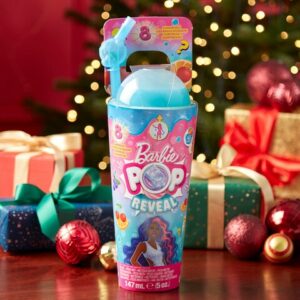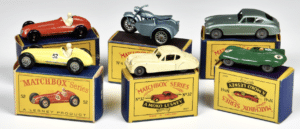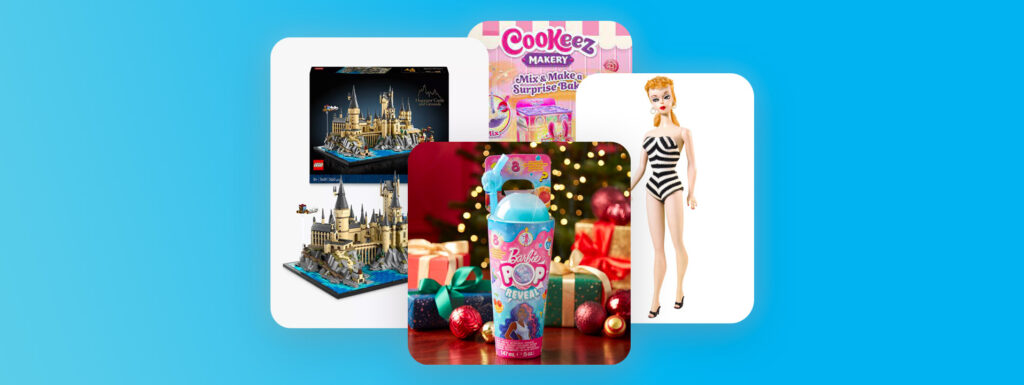We’ve compiled a series of intriguing gift lists that contain top Christmas Toys spanning several decades. One notable trend that stands out is Barbie’s enduring popularity, reigning supreme as the top toy in the 1950s and 2023! Let’s delve deeper into children’s toys’ diverse and captivating realm.
Why do we even give children toys at Christmas? Historically, the practice can be traced back to ancient Rome, where children received toys during the Saturnalia festival, a celebration held in December. This tradition was later adopted and adapted by Christians. The figure of Saint Nicholas, a 4th-century bishop known for his generosity to children, played a pivotal role in shaping the custom. Over time, Saint Nicholas’s feast day in early December became associated with gift-giving. As the celebration of Christmas and the birth of Jesus Christ gained prominence, these traditions gradually merged.
The tradition of giving toys at Christmas has its roots in various cultural and historical practices, but it notably gained momentum during the Victorian era. This period, marked by a cultural shift in how Christmas was celebrated, became more child-centric and family-oriented. The practice was influenced by stories like Charles Dickens’ “A Christmas Carol,” which emphasized the spirit of giving and the importance of family. Additionally, the Industrial Revolution played a crucial role in the mass production of toys, making them more accessible and affordable to the general public. Before this period, Christmas gifts were typically handmade and modest.

However, with the advent of mass-produced toys, they became a staple of Christmas celebrations. The image of Santa Claus, or Father Christmas, further popularized the tradition, as he was depicted as a jolly figure who delivered toys to well-behaved children. This blend of cultural change, industrial advancement, and folklore solidified the tradition of giving toys at Christmas, turning it into the much-anticipated practice we know today.
Let’s dive into top Christmas toys over the decades
We’ve gathered just a few examples, and the “top toy” can vary depending on the region and specific year. Each decade had unique trends and popular toys that reflected the cultural and technological advancements of the time.
- 1950s: The decade saw the rise of classic toys like Barbie, Mr. Potato Head, and the Hula Hoop.
- 1960s: This era was marked by the popularity of the Easy Bake Oven, G.I Joe, and Hotwheels.
- 1970s: The Star Wars action figures and the Rubik’s Cube were massive hits this decade.
- 1980s: This decade was dominated by the Cabbage Patch Kids dolls and the Nintendo Entertainment System.
- 1990s: Beanie Babies and the Tamagotchi virtual pet were among the most popular toys.
- 2000s: The Razor scooter and various iterations of the Xbox and PlayStation consoles were highly sought after.
- 2010s: Tablets for kids, like the iPad, and interactive toys like Hatchimals gained popularity.
- 2020s (up to 2023): The trend has leaned towards more technologically advanced toys, with items like interactive AI robots and advanced gaming consoles being popular.
What does the 2023 top Christmas toy list contain
The 2023 toy landscape vividly illustrates the balance between innovative, interactive toys and timeless classics. The prediction by industry experts that shoppers could spend around £1 billion on kids’ presents over the festive season speaks volumes about the significance and scale of the toy industry, especially during the holiday period.
While cutting-edge toys now often incorporate AI and interactivity, the enduring appeal of traditional toys is undeniable. For instance, Twister, number 20 on the list, first launched in 1966, has been reimagined with modern technology yet retains its original charm, demonstrating its lasting appeal nearly 60 years later.
Similarly, LEGO, originating in the 1930s, continues to captivate children and adults, consistently securing a place in the top toy lists, partly due to strategic partnerships with beloved book and movie franchises such as Harry Potter and Marvel. These collaborations have helped LEGO to remain a top choice, showcasing the power of traditional play in a high-tech world.

2. Beast Lab creator set


4. Cookeez Makery Oven Playset


6. Fluffie Stuffiez Large Plush

7. Harry Potter Hogwarts Castle & Grounds

8. Hot Wheels City Ultimate Hauler

9. L.O.L. Surprise! Magic Flyers

10. Little Live Pets My Puppy’s Home

How do the 1950s top toys compare to the AI and interactive list of 2023
The toys of the 1950s reflect a simpler time in American history, yet many remain iconic and valuable. For instance, the original Blonde Barbie Doll from 1959, characterized by its 1950s-style swimsuit and golden blonde hair, holds a staggering 2019 value of around $4,000. This underlines its collectible status and the enduring appeal of Barbie dolls.
Similarly, Mickey Mouse, an enduring creation of Walt Disney, remains as popular today as ever. The Mickey Mouse Roly Poly Figure from the 1950s, a hit among kids then, had a 2019 value of around $30, showcasing its lasting popularity across generations.
An interesting aspect of 1950s toys is the original Mr. Potato Head, which had a 2019 value of around $120. Initially, this toy was intended to be used with real vegetables, a concept that seems amusing today but also reflects the creativity and simplicity of toys from that era. This toy’s evolution mirrors changing perceptions about safety and play, transitioning from using actual food items to the plastic pieces we are familiar with today.
1. Original Blonde Barbie Doll (1959)
The first Barbie doll was notable for its 1950s-style swimsuit and golden blonde hair.
2019 Value: Around $4,000

2. Roy Rogers and Bullet Action Figure
Action figures celebrating the famous cowboy Roy Rogers and his horse, Bullet.
2019 Value: Around $250
3. Moko Lesney Matchbox Cars
Miniature die-cast cars are highly collectible and known for their detailed craftsmanship.
2019 Value: Around $150

Martel Maides Auctions
4. Howdy Doody Monkey
A doll inspired by Zippy, the popular guest star on the Howdy Doody TV show.
2019 Value: Around $100
5. 1950s Chiltern Hug-Me Teddy Bear
A cuddly teddy bear with distinctive fur epitomizes the classic teddy bear look.
2019 Value: Around $170
6. Lincoln Logs
Wooden log building sets allow children to construct miniature log cabins and structures.
2019 Value: Around $60

7. Fisher-Price Corn Popper
A push toy that makes a popping sound as it moves, simulating corn popping.
2019 Value: Around $30

8. Original Mr. Potato Head
Initially designed to be used with real vegetables, this toy allowed kids to create funny faces.
2019 Value: Around $120

9. Play-Doh
Originally a wallpaper cleaner, it became popular as a modeling clay for kids.
2019 Value: Original cans around $30
10. Mickey Mouse Roly Poly Figure
A toy featuring the iconic Disney character Mickey Mouse, designed to wobble but not fall over.
2019 Value: Around $30

11. Mobley Cat Squeaky Toy
A squeaky toy resembling a cat, offering a safe and non-scratching alternative to real pets.
2019 Value: Around $60
From simplicity to interactive and driven by AI – the toy evolution is a thing to behold
The evolution of top Christmas toys from the 1950s to 2023 reflects the dynamic changes in society, technology, and cultural trends. While the 1950s celebrated the simplicity and creativity of toys like the Original Blonde Barbie Doll and Mr. Potato Head, the 2020s have embraced technologically advanced and interactive toys, balancing the appeal of innovative, AI-driven toys with the timeless charm of classics like LEGO and Twister.
This journey from the traditional and tangible to the digital and interactive mirrors the broader evolution of our society, highlighting how playtime and childhood have adapted to the changing times. Yet, regardless of the era, the joy and excitement of receiving a cherished toy at Christmas remain a constant, cherished part of the holiday season.
If you’re interested in having a look at some inspiration, explore our blog on gift guides.

